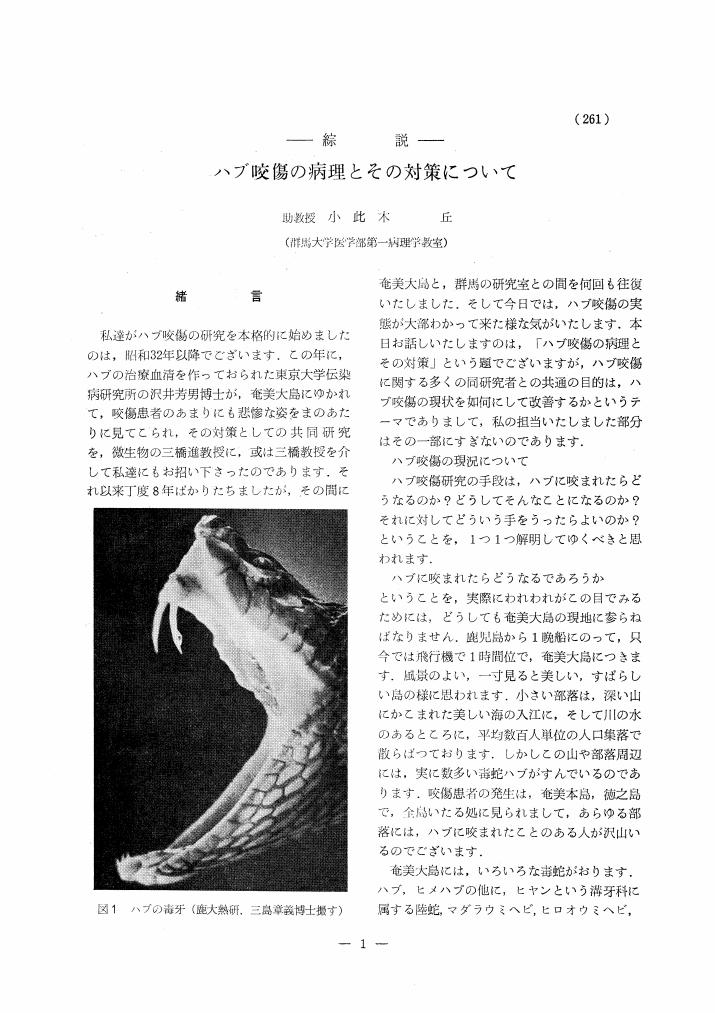2 0 0 0 OA ハブ毒とエラブウミヘビ毒の研究
- 著者
- 本間 学 阿部 良治 小此木 丘 佐藤 信 小管 隆夫 三島 章義
- 出版者
- 日本細菌学会
- 雑誌
- 日本細菌学雑誌 (ISSN:00214930)
- 巻号頁・発行日
- vol.20, no.6, pp.281-289, 1965-06-25 (Released:2009-02-19)
- 参考文献数
- 24
- 被引用文献数
- 3 3
This paper outlines the natures of Habu snake and Erabu sea snake and properties and actions of their venoms. Moreover was described the effect of tannic acid on the venoms.Habu snake (Trimereserus flavoviridis) is venomous, landinhibiting on the Amami islands and about 150cm long. The victims of Habu snake bite was estimated at 250 to 300 each year. The death rate during recent 7 years was more than 1 per cent. The minimal lethal dosis for mice, weighing 15 to 17g. was about 150γ/0.1ml by intramusculare injection. It was considered that the venom was composed of haemorrhagic, angiotoxic and myolytic factors, which were completly inactivated by heating at 100C for 10 minutes, and heat-stable myolytic factor.Erabu sea snake (Laticauda semifasciata) lives on the coast of Amami Oshima, and has strong fatal venoms. Minimal lethal dosis, in experiments with mice weighing 15 between 17g., was about 6γ/0.1ml by the intramusculare injections. Erabu sea snake venom is considered to have chiefly neurotoxic component which was relatively stable in heating.It was recognized that the toxic activities of the venoms of these different species were inhibited by aqueous solution of tannic acid; a 8.5% solution inactivated lethal and local haemorrhagic activities of 500γ/0.1ml of Habu snake venom, and fatal toxicities of 25γ/0.1ml of Erabu sea snake venom.The above mentioned effect of tannic acid on the venoms may be due to coagulations of the venom and tissue proteins by tannic acid.
1 0 0 0 OA ハブ蛇毒中に含まれる耐熱性毒性物質について
- 著者
- 小此木 丘 星 昭二 本間 学 須藤 謙三郎 飯塚 久義 佐藤 信
- 出版者
- The Kitakanto Medical Society
- 雑誌
- 北関東医学 (ISSN:00231908)
- 巻号頁・発行日
- vol.12, no.3, pp.199-207, 1962 (Released:2009-11-11)
- 参考文献数
- 15
- 被引用文献数
- 2 1
An injection of Habu-snake venom, heated for 10 minutes at 100°C., caused myolysis at the site, histologically. But different from crude venom action, no hemorrhagic changes were recognized. At first, disappearance of mitchondria in the muscular fibers was seen, and then muscular splitting and lysis followed.While the myolytic changes caused by crude venom began immediately af ter the injection, the beginning of the changes were delayed when the heated material were used.Anti-Habu-serum neutralised the toxicity of the heated venom, and also, E.D.T.A.-Ca, Cocarboxylase and α-Thiolactoylglicine-Na repressed the toxicity in vitro.
1 0 0 0 OA ハブ咬傷の病理とその対策について
- 著者
- 本間 学 阿部 良治 小此木 丘 佐藤 信 小管 隆夫 三島 章義
- 出版者
- JAPANESE SOCIETY FOR BACTERIOLOGY
- 雑誌
- 日本細菌学雑誌 (ISSN:00214930)
- 巻号頁・発行日
- vol.20, no.6, pp.281-289, 1965
- 被引用文献数
- 3
This paper outlines the natures of Habu snake and Erabu sea snake and properties and actions of their venoms. Moreover was described the effect of tannic acid on the venoms.<br>Habu snake (<i>Trimereserus flavoviridis</i>) is venomous, landinhibiting on the Amami islands and about 150cm long. The victims of Habu snake bite was estimated at 250 to 300 each year. The death rate during recent 7 years was more than 1 per cent. The minimal lethal dosis for mice, weighing 15 to 17g. was about 150γ/0.1ml by intramusculare injection. It was considered that the venom was composed of haemorrhagic, angiotoxic and myolytic factors, which were completly inactivated by heating at 100C for 10 minutes, and heat-stable myolytic factor.<br>Erabu sea snake (<i>Laticauda semifasciata</i>) lives on the coast of Amami Oshima, and has strong fatal venoms. Minimal lethal dosis, in experiments with mice weighing 15 between 17g., was about 6γ/0.1ml by the intramusculare injections. Erabu sea snake venom is considered to have chiefly neurotoxic component which was relatively stable in heating.<br>It was recognized that the toxic activities of the venoms of these different species were inhibited by aqueous solution of tannic acid; a 8.5% solution inactivated lethal and local haemorrhagic activities of 500γ/0.1ml of Habu snake venom, and fatal toxicities of 25γ/0.1ml of Erabu sea snake venom.<br>The above mentioned effect of tannic acid on the venoms may be due to coagulations of the venom and tissue proteins by tannic acid.
